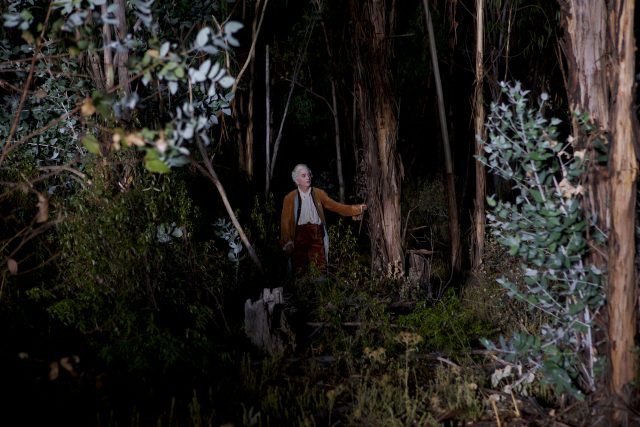
Albert Serra’s Liberté vividly depicts a night of debauchery on the eve of the French Revolution
LIBERTÉ (Albert Serra, 2019)
Film at Lincoln Center
Through May 7, $12 for three-day rental
www.cinemaguild.com
Catalonian auteur Albert Serra’s Liberté seems tailor made for these challenging times, as so much of America hunkers down at home, sheltering in place because of the coronavirus. The fetishistic fête, which played festivals last year and is currently enjoying its exclusive virtual theatrical release via Film at Lincoln Center’s website, is a voyeur’s dream or nightmare, depending on how you look at sadomasochistic rituals and orgies. In Serra’s previous film, 2016’s brilliant The Death of Louis XIV, nearly all the action took place in the crowded bedchamber of the Sun King as he faced the end of his life. Liberté, set in a German forest, “a cursed place,” on the eve of the French Revolution, has a similarly claustrophobic feel. Both films were shot with three cameras: Serra’s technique means the actors don’t know which camera to perform to and don’t know exactly what the cameras are focusing on or which parts of their bodies are in the frame. In Liberté, this results in a dark vulnerability, especially given what body parts are shown, from afar and in extreme close-up.
For 132 slow-moving but intense minutes, we watch a cast of professional and nonprofessional actors touch themselves and one another, remove articles of extravagant clothing, perform ever-more-graphic acts of sex and violence (it’s often difficult to tell what is simulated and what is not), discuss bestiality, God and Jesus, killing, and politics, and, perhaps most important, gaze luridly at each other. In every scene, as we, the audience at home, follow the radical, vivid goings-on, at least one other character, and often more, are already in the composition, watching as well, or slowly entering the scene from the periphery, and our vision picks up the slightest motion emerging from behind a tree or a bush as we spot another voyeur, like a bug or a wild animal materializing from the darkness. At one point, a man with an extended spyglass peers around the area and ultimately faces us directly; thus, everyone knows they are being watched — we are all implicated. In addition, cinematographer Artur Tort rarely moves his camera; there are no active zooms, pans, or dollies, very little camera movement at all. Serra is not telling us what to look at; we scan the scenes individually, deciding for ourselves where to direct our attention (and what to turn away from). This is especially poignant when we are in our house or apartment on a computer, where we value our privacy and, perhaps, dabble in bits of pornography here and there, at least when our partners or children might not be around, which of course they always are now. Watching Liberté in a crowded theater with strangers would be a very different experience.
Liberté was first staged as a controversial German play in 2018 at the Volksbühne in Berlin, followed by the multimedia art installation Personalien at the Museo Reina Sofía in Madrid last year. The bold, daring cast, which improvises heavily throughout the film, features Helmut Berger as Duc de Walchen, Marc Susini as Comte de Tésis, Iliana Zabeth as Mademoiselle de Jensling, Laura Poulvet as Mademoiselle de Geldöbel, Baptiste Pinteaux as Duc de Wand, Théodora Marcadé as Madame de Dumeval, Alexander Garrcía Düttmann as Comte Alexis Danshir, Lluís Serrat as Armin, Xavier Pérez as Capitaine Benjamin Hephie, Cătălin Jugravu as Catalin, Montse Triola as Madam Montavrile, Safira Robens as Mademoiselle Rubens, and Francesc Daranas as the Libertine. While the women are beautiful by traditional standards, the men come in all shapes and sizes, some stunningly handsome but most not. The acts they perform will entice some viewers and disgust others; very little is left to the imagination (although there are no scenes of actual penetration).
The film recalls Stanley Kubrick’s Eyes Wide Shut, David Cronenberg’s Crash, and William Friedkin’s Cruising, with an ample dose of Charles Bukowski, going well beyond Fellini’s Casanova, Lars von Trier’s Nymphomaniac, and Tinto Brass’s Caligula. The costumes, compositions, and scenery, which includes a palanquin where certain more private seductions occur, were inspired by the Baroque paintings of Alexandre-Évariste Fragonard and François Boucher, lending an elaborate elegance that speaks to class, wealth, and power. Dialogue is sparse but striking. “Let me describe a scene that would be most pleasurable for me,” one man says. “Is that enough?” someone asks of a woman who cries out for more. “Finally, an image that satisfies me,” a character declares approvingly of a sight that might not satisfy you. Editors Ariadna Ribas, Serra, and Tort had more than three hundred hours of continuous footage to sift through, shot in less than three weeks, using no music till the end, the primary sounds being insects, groans, whispers, grunts, and screams. It has been intricately edited down to portray one debauched night during which no holds are barred and everyone can act as freely as they desire, societal morals be damned. We are immersed in this perverse world that grows more and more shocking by the second, exposed to tableaux most of us have never seen before onscreen – or in real life. Serra (Honor of the Knights, Birdsong, Story of My Death) is not judging anyone, and he’s not asking us to judge either, although you’ll be hard-pressed not to want to know more about the making of this ravishing, rebellious film and Serra’s intentions. To do so, check out his 2019 Q&A at the New York Film Festival and the May 3 online Q&A, although he only gives up so much.